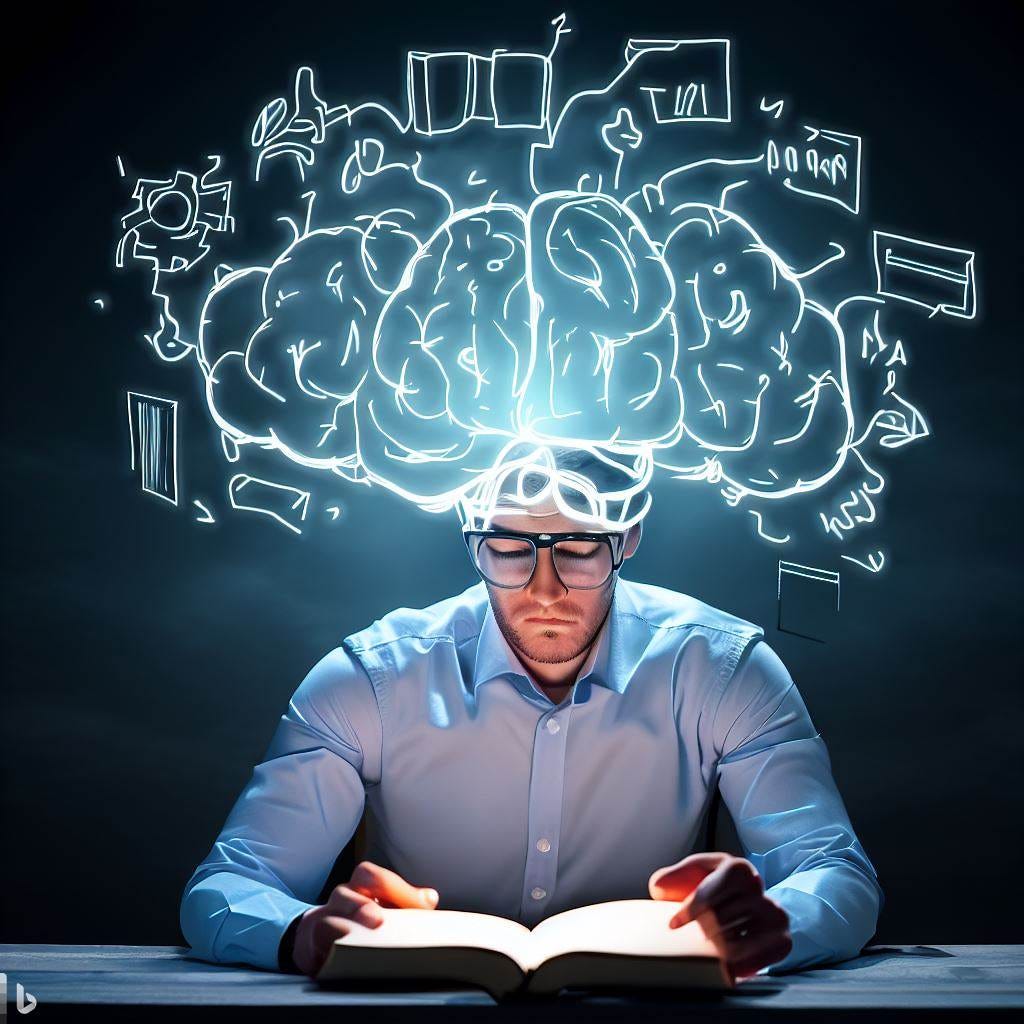After 30 years, I still remember one of the engineering school lectures. The professor said that over 90% of what we learned about technologies would be obsolete when we graduate. The main reason for higher education is learning how to learn (meta-skills).
[image credit from Bing AI Image Creator]
Why learn outside of school?
Many see schooling as the path to getting academic certificates. The qualification is the prerequisite to getting a good job. A good-paying job is to be able to have a good life, and once we start working, we stop reading books or studying.
In V-Work’s OLO organic learning practice, we encourage everyone to be a T-shape general specialist. T-shape competency is having broad horizontal general knowledge about everything (生活杂学) and having at least one deep area of expertise (Personal Mastery). Expertise is even better if it is a skill in demand (people willing to pay for it), and we enjoy this field of interest.
The shallow general knowledge opens our minds to connect the dots, open the door for conversation or learning another subject, and be less ignorant (or arrogant). The wiser person is often more tolerant of diverse opinions and appreciates other disciplines (principles and practices).
This Bear Path public journal is one of my practices to explore diverse general knowledge and learn about different topics that come to mind weekly. I find this very interesting and how much I do not know (or unclear).
To have an interesting life is to have a curious mind. Keeping an inquisitive mind like a toddler ignites the passion for lifelong learning. Living interesting days keeps us young at heart and strengthens our mental health. We need to be interested (curious) about the opponent before they show interest in what we have to say. Actively listen first to understand before we speak to be understood.
Seek first to understand, then to be understood. - Stephen Covey
Modes of Learning
There are 2 modes of our learning mind. This coincides with our fast-thinking and slow-thinking brains.
(i) the focused mode - attention, immersive learning
(ii) the diffused mode - creative and relaxed. Practicing something you have learned from the focused mode in the diffused mode is great. I like to listen to music or even watch some music reality show in the background
My schoolmate used to wonder how I studied while listening to music with the Walkman (in case you are not as old as me, Walkman back in the 80s was like Spotify or Apply music to the high school kids in 2023). Now, I realize that I am rehearsing in a diffused mode. I also like to doodle in my textbooks, and later, I learned that technique is called mind mapping.
If we learn a new skill deliberately, like how to play the piano, we need a focused mind and immersive learning. However, I can recall the lyrics of many pop songs back in the 80s by simply passively singing along with the music; that was through the diffused mode of learning.
It is important to know that we are unique individuals. One needs to find the preferred ways to learn. Most people, like myself, are visual; some like hands-on learning (kinesthetic), and some learn better from audiobooks (auditory), etc. The learning content also influences whether visual is better for understanding structure, hands-on is for muscle memory, and audio is suitable for children with Dyslexia or busy executives.
How to learn
In the book Ultralearning by Scott Young, Young suggested 3 steps for any ultra-learning project that can be useful for our consideration.
meta-learning map - breakdown of the essential skills to acquire the new skill
practice drill - focus on your weak link (skills that need more practice)
overlearn - practice at a higher standard than what is required
There are many fundamental skills (meta-learning) that are vital in helping us to learn, such as:
Pattern recognition (connecting the dots, problem-identification etc.)
Self-awareness (metacognition, reflection, feedback loop, emotional quotient)
Critical thinking (analytic, problem-solving, etc.
Perspective (views)
Prioritizing (relevancy, importance etc.)
Soft skills (interpersonal skills)
Motor skills and sensory skills (flexibility, sensitivity, endurance etc.)
Unlike traditional schooling, where the students are asked to memorize historical dates and events where a simple Internet search can find the record, organic learning prefers to seek the truth and relevancy. We do not have to waste time learning/memorizing it if it is not essential.
In OLO organic learning, I use the 4 steps (CCCP) in iterative mastery loops:
curiosity
interest boosts our passion for learning
preparation to learn (schedule your learning plan, research the resources)
using structural learning
comprehension
clarify using questions
memorize with story and emotions (remember)
understand with comprehension
convert the knowledge as your own wisdom (can apply or teach others)
critical
validate the relevancy and trustworthiness (seek the truth)
discard if the contents are more noise than signal, irrelevant, or unimportant
we are in the school of life. If I were a monkey, I would not have to swim as well as the fish in the same class. I can focus on climbing.
practice
a faster way to learn is to practice and make mistakes (feedback loop, iteration drills), start with a baby step, what I can do or look up right now?
immerse in an environment that encourages you to practice (e.g. travel to the country or stay in a neighborhood that speaks the new language you want to master)
Self-tests, if you are studying for an examination, practicing active recall
and teaching others, are the best ways to deepen your understanding. As Richard Feynman said, if we cannot explain the concept in our own words to a 12-year-old kid, we don’t understand the topic well enough.
Structural Learning
In this simple context (say learning new knowledge without involving new motor skills), I like to share structural learning, which can help us learn faster and articulate better (if we are presenting the knowledge).
cluster - circles, bubbles, grouping similarities, segmentation, quadrant, matrix, what is overlapping and what is excluded, information container, a solution block diagram
sequence - line, process, procedure, timeline events, function flow diagram
connection - mesh, causal loop (systems thinking)
hierarchy - branch, mind map, chunking up/down
perspective - the view or lens from which role (or actor), 2D to 3D views, models (simplified representations)
Using structure helps us to define the information anatomy. It sets up the ‘containers’ or boundary (as a framework) to place temporary information we gather into a placeholder. It later allows us to reposition and re-connecting the dots.
We can use structural learning for business requirement study, problem-solving, and new knowledge in business.
How to make notes (not ‘take’ notes)
We take lecturing notes in school and take minutes of work meetings. The most common mistake I used to make was ‘taking notes’, not ‘making notes’. I started off by transcribing word by word what the speaker said. The result was terrible; I could not keep up with the speaker’s pace and did not know many of the words (and how to spell them), and the worst part is I was so busy capturing the words I ignored the speaker’s non-verbal communication, and also not trying to understand the concept. In the end, I have many transcribed words but little comprehension.
If we capture the information using structural learning (sketching diagrams and illustrations) instead of writing pages of words, we can create a story that captures the essence.
How do we learn from books?
analyze the structure of the argument presented by the author
make remarks and notes on the book (if you purchased the book)
summarize key concepts in your own words
transfer the knowledge onto a second brain (for example, I am using Logseq)
Again, we can see that the trick lies in the ‘structure’, the skeleton of information architecture, or the story's backbone.
Other Factors
Here are some tips from my personal experience, which may or may not be applicable to your mastery of faster learning. Feel free to comment and share what works for you that could benefit other readers.
good sleep helps us to process the learning
exercise and boosts the rate of learning
having a growth mindset helps. A fixed or closed mindset tends to put us in a learn-helplessness mode that fails to see that most competencies are learnable skills
Don’t be shy about asking for help. Wiser people are kinder than we think, and they are not stingy in coaching those who could benefit from their advice
Stress is counter-productive for learning; hence, use awareness to know you are in the optimum state for learning. If not, reschedule a better time to learn
Weekly Update
I watched “John Wick Chapter 4”, which is better than “Operation Fortune”.
Chapter 4 has the best action choreography in the John Wick series, and it sets a new bar for Hollywood action movies with the John Wick style of the ‘gun-fu’ (gun with kungfu) fight scene.
It is interesting to see the mental models and the ‘codes’ of conduct. Similar philosophies are seen in Star Wars (‘May the force be with you’) and The Mandalorian (‘That’s the Way’). We can also see the virtues of Stoicism in John Wick.
“Without the rules, we are nothing but animals.” Socrates
[John Wick Chapter 4 official trailer]
I will continue to cook different dishes and explore more varieties. This was my first attempt to cook kale with berries, nuts, and passion fruit enzymes.




Learning can be the ultimate excuse for procrastination. Life-long learning is not about aimlessly studying and information hoarding, the ultimate objective is to practice, execute and express our creative output.